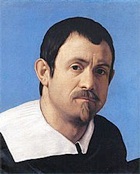
Self portrait (ca. 1650)
Presented by Cardinal Flavio Chigi to Duke Cosimo III de' Medici in 1683
Now in the Galleria degli Uffizi, Florence
Giovanni Battista Salvi, who was born in the small town of Sassoferrato in theMarches, trained under his father, Tarquinio Salvi. He seems to have continued his training in Bologna. He moved to Rome in ca. 1640 and spent the rest of his career there. He was particularly appreciated for his talent for copying Renaissance sacred paintings, usually of the Madonna and Child. Indeed, he was known as the “pittore delle belle Madonne”.
Perugia
Works in San Pietro
Madonna of the Lilies (1632-6)
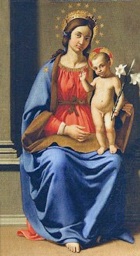
Pope Urban VIII sanctioned Abbot Leone’s transfer of the original from the Villa di Valliano to a chapel specifically built for it in San Pietro in 1643. Both the original and Abbot Leone’s copy are now in chapels off the left aisle of San Pietro:
-
✴The original is now in the Cappella del Sacramento.
-
✴Abbot Leone’s copy by il Sassoferrato is now on the right wall of Cappella Vibi.
Copies were also made for Urban VIII , for Cardinal Francesco Barberini (the protector of the Cassinese congregation) and for other abbeys for which Abbot Leone was responsible (including San Pietro, Assisi). However, all these have been lost.
Deposition (1638)
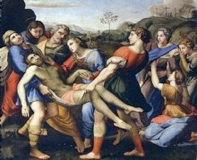
This panel by il Sassoferrato in San Pietro (between the Cappella Ranieri and the Cappella Vibi, in the left aisle) is a faithful copy of the main panel of Raphael’s Pala Baglioni (1507). (The original was removed from San Francesco al Prato in 1608 and is now in the Galleria Borghese, Rome).
Saints (17th century)
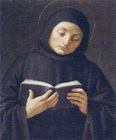
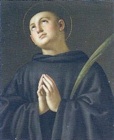
St Maurus St Placidus
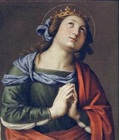
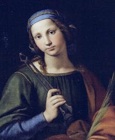
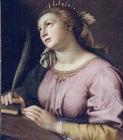
St Justina St Apollonia St Catherine
A document of 1792 records that: “In the rooms [of the abbot, there are panels depicting] SS Benedict, Scholastica, Maurus, Placidus, Flavia [. . .] in half-length figures. They are all beautiful copies taken from various originals of Raphael, Pietro Perugino and other illustrious men, by ... the most accurate Sassoferrato”.
Five of these are now in the right aisle of San Pietro:
-
✴two above the door to the monastery:
-
•St Maurus; and
-
•St Placidus; and
-
✴three above the door to the sacristy:
-
•St Justina (the patron of the Cassinese congregation, incorrectly identified as St Flavia in the list of 1792);
-
•St Apollonia (carrying the pincers with which he teeth were torn out);
-
•St Catherine of Alexandria
The figures of SS Maurus, Placidus, Justina and Scholastica replicate (at almost twice the size) figures from the predella of from Perugino’s San Pietro Polyptych (1496), which would have been in the sacristy when il Sassoferrato copied them. (The panels of SS Maurus and Scholastica, this latter badly damaged, are still in the sacristy, while those of SS Placidus and Justina are in the Pinacoteca Vaticana, Rome). [Scott Nethersole and Helen Howard suggest that a small panel of the Baptism of Christ in the National Gallery is also a copy by Sassoferrato of a predella panel from this polyptych, but there is no evidence that the copy was made for San Pietro.]
SS Benedict and Scholastica (17th century)
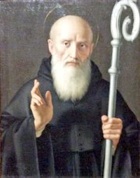
Saints (17th century)
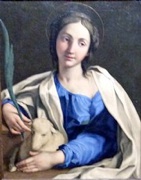
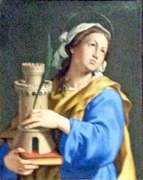
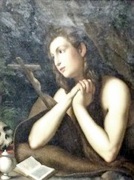
These three panels by Sassoferrato are now in the Galleria Tesori d’ Arte at the Abbazia di San Pietro, Perugia. They depict:
-
✴St Agnes;
-
✴St Barbara; and
-
✴the penitent St Mary Magdalene.
Annunciation (17th century)

Judith and Holofernes (17th century)
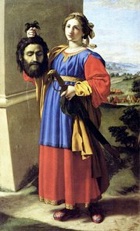
Immaculate Conception (ca. 1650)

Other Works in Perugia
Virgin in Prayer (ca. 1660)
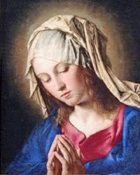
Todi
Virgin in Prayer (17th century)
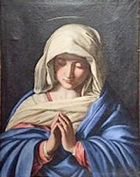
Read more:
C. Prete (Ed.), “Sassoferrato; ‘Pictor Virginum’: Nuovi Studi e Documenti per Giovanni Battista Salvi”, (2010) Ancona
S. Nethersole and H. Howard, “Perugino, Sassoferrato and a ‘Beautiful Little Work’ in the National Gallery, London”, Burlington Magazine, 152: 1286 (2010) 376-84
Return to Art in: Perugia Todi
Return to “Foreign” Painters in Umbria.



